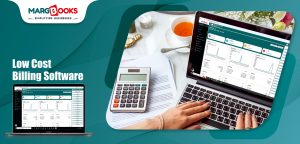India’s import-export sector has seen a massive digital transformation in recent years, making trade processes more efficient and transparent. One such crucial document in the import process is the Bill of Entry (BoE), which is filed online through the Indian Customs Electronic Data Interchange (EDI) system. If you are an importer, understanding this process is essential to ensure smooth clearance of goods. Let’s break down the process of submitting a Bill of Entry online and how the right Billing Software, Accounting Software, and Inventory Management Software can help streamline the process.
What Is a Bill of Entry?
A Bill of Entry is a legal document that importers must submit to customs authorities when bringing goods into India. It contains details about the imported goods, including their description, quantity, value, and applicable duties. Filing a BoE is mandatory for customs clearance, and failure to do so can result in delays and penalties.
Step-by-Step Process to Submit a Bill of Entry Online
The Indian Customs EDI system has simplified the submission of BoE, making it a hassle-free process. Here’s a step-by-step guide:
Step 1: Registration on ICEGATE Portal
- Importers must register on the ICEGATE (Indian Customs EDI Gateway) portal.
- Create a user ID and password.
- Submit necessary business documents for verification.
Step 2: Obtaining Importer Exporter Code (IEC)
- An IEC issued by the Directorate General of Foreign Trade (DGFT) is required to import goods.
- It acts as a unique identification number for your business.
Step 3: Gathering Required Documents
Before filing a BoE, ensure you have:
- Commercial Invoice
- Packing List
- Bill of Lading or Airway Bill
- Insurance Certificate
- Letter of Credit (if applicable)
- Import License (if required)
Step 4: Filing the Bill of Entry Online
- Log in to ICEGATE: Enter your credentials and navigate to the BoE submission section.
- Select Type of Bill of Entry: Choose from Home Consumption BoE, Warehousing BoE, or Ex-Bond BoE based on your import type.
- Enter Details: Fill in all mandatory fields such as:
- Importer details
- Supplier details
- Goods description (HSN code, quantity, and value)
- Customs duty calculation
- Upload Supporting Documents: Attach scanned copies of required documents.
- Submit and Pay Duties: Once verified, pay the applicable customs duties online.
Step 5: Assessment and Verification by Customs
- Customs officers review the BoE and may request additional documents or clarifications.
- If everything is in order, the BoE is assessed, and duties are finalized.
- In some cases, a physical inspection of goods may be required.
Step 6: Generation of Clearance Message
- After approval, a clearance message is generated.
- Importers can then proceed with logistics arrangements to take delivery of the goods.
How Billing Software, Accounting Software, and Inventory Management Software Help in BoE Submission
Using the right digital tools can significantly simplify the BoE submission process. Here’s how:
Billing Software
- Automatically generates invoices with necessary details for BoE filing.
- Ensures tax compliance with GST-ready invoices.
- Reduces manual data entry errors.
Accounting Software
- Keeps track of import expenses and duties paid.
- Integrates with GST filings for seamless compliance.
- Provides financial reports for better decision-making.
Inventory Management Software
- Helps keep track of imported goods and stock levels.
- Ensures real-time updates on inventory status.
- Prevents overstocking or understocking issues.
Margbooks: A Smart Solution for Import Businesses
If you’re looking for a complete software solution to manage your import business, Margbooks is an excellent choice. This cloud-based software offers:
- Billing Automation: Generate invoices instantly.
- Accounting Integration: Manage all financial transactions efficiently.
- Inventory Tracking: Keep track of stock levels in real-time.
- GST Compliance: Ensure tax filings are error-free and timely.
With Margbooks, importers can seamlessly manage their finances and inventory while ensuring compliance with customs regulations.
Conclusion
Submitting a Bill of Entry online is now easier than ever, thanks to the digitalization of the customs clearance process. By following the steps outlined above, importers can ensure smooth and hassle-free submission. Additionally, using the right Billing Software, Accounting Software, and Inventory Management Software like Margbooks can make the entire process more efficient. Investing in such digital solutions will not only save time but also minimize errors, ensuring compliance with Indian customs regulations.




